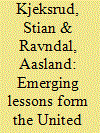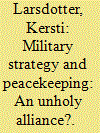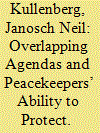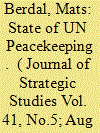|
|
|
Sort Order |
|
|
|
Items / Page
|
|
|
|
|
|
|
| Srl | Item |
| 1 |
ID:
106198


|
|
|
|
|
| Publication |
2011.
|
| Summary/Abstract |
Since December 2008, protection of civilians has been the primary task of the United Nations (UN) mission in the Democratic Republic of Congo (DRC). Guidance on how UN military units can contribute to the protection of civilians has been lacking, however. This has necessitated a bottom-up approach to protection of civilians in which the mission and its partners have developed a series of cross-cutting protection initiatives. The UN military plays a key role in many of them. Based on the findings of a 2010 field study conducted in the DRC, the paper discusses how UN military units can contribute to protection of civilians in three dimensions, namely civil-military cooperation, the use of intelligence, and the use of military force. The aim is to inform the preparation of military contributions to future missions mandated to protect civilians.
|
|
|
|
|
|
|
|
|
|
|
|
|
|
|
|
| 2 |
ID:
123460


|
|
|
|
|
| Publication |
2013.
|
| Summary/Abstract |
The eastern Democratic Republic of Congo (DRC) has been characterised by chaos and insecurity for a number of years, but the rise of the M23 rebellion in 2012 once again highlighted just how dire the humanitarian and security situation is. For most of 2012, the crisis was addressed through negotiations between M23 and Kinshasa, mediated by the International Conference on the Great Lakes Region (ICGLR). However, 2013 marked the signing of the Peace, Security and Cooperation Framework Agreement (PSC Framework), and the United Nations Security Council's adoption of Resolution 2098, which contains the mandate of the long-awaited Intervention Brigade (IB). The PSC Framework calls on Kinshasa to implement substantial political reforms while also urging the neighbours of the DRC to stop interfering in its internal affairs. The IB is mandated to carry out targeted operations against the so-called 'negative forces' that operate in the eastern DRC. For now, hope of resolving this ongoing crisis hinges on the continuing ICGLR negotiations, the implementation of the PSC Framework and the success of the IB. However, there are critical questions about all of these processes that need to be answered and understood, as the expectations for these processes - especially in the case of the IB - are extremely high. Will the ICGLR manage to negotiate a peace agreement and will the IB succeed, or will they go down in history as yet another failure to save the eastern DRC?
|
|
|
|
|
|
|
|
|
|
|
|
|
|
|
|
| 3 |
ID:
165098


|
|
|
|
|
| Summary/Abstract |
Despite the increased use of military force in peacekeeping operations in the twenty-first century, these operations are not included in traditional strategic theory. In this article, I outline the logic of four strategies for peacekeeping operations – defence, deterrence, compellence and offence – and trace the use of these strategies in two consecutive UN operations in the Democratic Republic of the Congo: MONUC and MONUSCO. The article concludes that all four strategies are indeed used in the two operations, but they are neither comprehensive nor proactive, leaving the true potential of military strategy unrealised.
|
|
|
|
|
|
|
|
|
|
|
|
|
|
|
|
| 4 |
ID:
106200


|
|
|
|
|
| Publication |
2011.
|
| Summary/Abstract |
When MONUC (the Mission de l'Organisation des Nations Unies en République Démocratique du Congo) was first deployed in the Democratic Republic of Congo (DRC) in late 1999, the territorial integrity of the DRC was at stake as the country was divided into autonomous f?efdoms controlled by the national government and several rebel groups. Concomitantly, the country also played host to a number of foreign national armies as well as non-state armed groups that took advantage of the confused situation in the DRC to pursue their respective security, economic, or simply survival agendas. In over a decade of deployment, MONUC contributed greatly to the preservation of the DRC's territorial integrity. The mission also played a crucial role in establishing relative peace, security and stability in central Africa's largest state. However, all these achievements could not wipe away significant shortcomings experienced by MONUC, stemming from both internal and external factors to the mission, especially with regard to the protection of civilians.
|
|
|
|
|
|
|
|
|
|
|
|
|
|
|
|
| 5 |
ID:
179555


|
|
|
|
|
| Summary/Abstract |
This article scrutinizes the overlaps between three major UN policy agendas to explain how their interaction impacts the delivery of protection, particularly against conflict-related sexual violence (CRSV). Building on Pierre Bourdieu, it reconstructs the ‘field of international interventions’ and subsequently analyses the evolution of the protection mandate, highlighting the complementarities and contradictions between Children and Armed Conflict, Protection of Civilians and Women, Peace and Security. My findings suggest that while these agendas have reinforced each other during their establishment and institutionalization, the multiplication of administrative structures has also led to the compartmentalization of protection. The field’s competitive pressures, furthermore, push organizations to focus on their own mandates and subsume aspects of other agendas under them. Data from the Democratic Republic of Congo indicate that despite recognizing the need for gender-sensitive approaches, UN peacekeeping largely continues to understand protection against CRSV as part of its general protection efforts. Therefore, the militarized and gender-ignorant approach to protection prevails and specific measures to address sexual violence remain too headquarters-driven.
|
|
|
|
|
|
|
|
|
|
|
|
|
|
|
|
| 6 |
ID:
160029


|
|
|
|
|
| Summary/Abstract |
The article considers the state of UN peacekeeping through the prism of its long-running operation in the Democratic Republic of the Congo (DRC). Focusing in particular on the challenges raised by use of force and the protection of civilians in conditions of ongoing armed conflict, it argues that UN field operations must be aligned much more closely than they have been over the past 15 years to political and diplomatic efforts aimed at securing viable political settlements to internal conflict. The issues raised by the history of the UN’s troubled mission in the DRC are deeply relevant to the wider discussion of the organisation’s role in the field of peace and security.
|
|
|
|
|
|
|
|
|
|
|
|
|
|
|
|
| 7 |
ID:
147774


|
|
|
|
|
| Summary/Abstract |
IN 2015, the world marked the 70th anniversaries of two key events of the 20th century. One of them was the end of the Great Patriotic War and World War II. The other was the establishment of the United Nations, an organization entrusted with the mission of consolidating peace that had cost so much to achieve. The United Nations' number one objective as stated in its Charter, which came into force on October 24, 1945, is "to maintain international peace and security, and to that end: to take effective collective measures for the prevention and removal of threats to the peace..."1 Seven decades later, the organization's ability to follow this commandment by adapting to new threats and challenges is increasingly called into question.
|
|
|
|
|
|
|
|
|
|
|
|
|
|
|
|
|
|
|
|
|